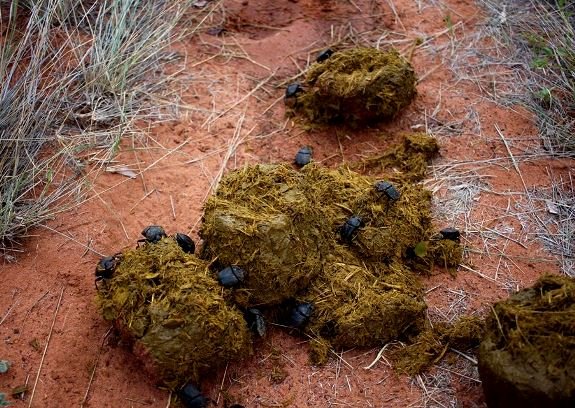Dung beetles at work

Author: Ivan Lätti
Photographer: Eric Aspeling
Elephant dung turned into a vibrant dung beetle workplace is but one of the carrying away and food burying sights produced by these beetles belonging to the order Coleoptera (over 360000 species), superfamily Scarabaeoidea (about 35000 species) and family Scarabaeinae (about 1000 species, the true dung beetles).
The ones in picture are black, while several other colours occur, often metallic. Many dung beetles are nocturnal and some can fly, even following the wildebeest on the Serengeti migration, servicing their dung all the way. (Now if there could one day be plastic consuming beetle robots, the earth might be a better place… come on, you inventors!)
Most of the true dung beetles feed exclusively on dung, while some also eat carrion, decaying fruit or fungi. The mouth part of the adult is adapted to fit this lifestyle.
Dung beetles of the ball rolling kind are best known as people notice them, being fascinated with ball games. They transport, eat and lay their eggs inside their dung balls for the babies to eat their way out of the stuff. These beetles are also the most ambitious, adroit and industrious of their clan as the rest might be considered slothful family embarrassments: The other two “guilds” to which dung beetle species belong are the tunnellers and the dwellers.
The tunneller dung beetles dig tunnels and nest right there below the discovered food source. They transport the food down for feeding and while they’re at it, promptly reproducing since all the requirements are conveniently at hand (or at other body parts).
The laziest of the lot, the dwelling dung beetles, enter the dung to stay, to dwell there. They eat and reproduce without moving on, not bothering with any inessential exertions. Burying dung aerate the soil and improves its fertility, so they also serve who only sit and eat.
Tree seeds that passed through the elephant’s digestive system and positioned opportunely by dung beetles are an ecological boon. Dung beetles therefore also plant trees for posterity under which they shall never sit (Wikipedia; www.msn.com).

